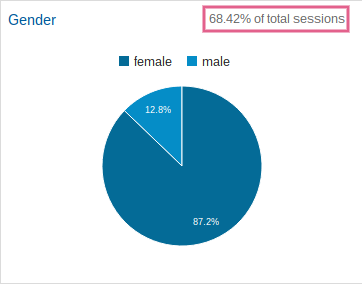OUT OF DATE: These instructions were originally provided for Universal Analytics. This version of Google Analytics is no longer available.
The equivalent feature in Google Analytics 4 is now Google Signals. Learn more about enabling and using Google Signals in GA4 (InfoTrust).
Google Analytics lets us see all sorts of interesting things about our visitors, like where they came from, what city they’re in, or what search term they used. But there’s a whole bunch of information that you’ve probably never seen!
Demographics.
Yep, that’s gender, age & interests straight into your Analytics reports!

Turn it on
Head over to the official Help document for enabling Demographics and Interests reports.
How is this information gathered?
According to Google, all of the Demographics data comes from the DoubleClick advertising cookie. This means that everything is gathered and assumed/correlated based on an individual’s browsing history. Even though they could get personal information straight out of a person’s Google account (if they were logged in while visiting your website), I don’t believe that this is what goes into the Demographics reports.
It also means that not all of your visitors are included.
- Those who block all cookies won’t be tracked by Google Analytics at all.
- Some people just block DoubleClick (and other advertising platforms).
- Some visits are hidden from the reports for privacy reasons, too (more about that later on).
You can see how many of your total visits are included at the top of all the Demographics and Interests reports:

What Demographics are included & how is it useful?
Gender
Google puts people into two gender categories: male and female. This appears to be assumed based on a person’s behaviour and interests, so it’s more like “acts traditionally male” and “acts traditionally female”.
The Gender that Google selects seems to be pretty reliable. Find out what Google thinks about you.
Knowing the assumed gender of your visitors lets you answer questions like:
- Are most of my visitors male or female?
- How does this match up with the sales I make (if you can guess the gender of most buyers)?
- If I mostly sell to females, but I actually get 20% of my product views from males, how can I get them to buy?
- If I write “general” product descriptions because I thought both males & females would be interested, but I’m actually seeing 80% of my visits from females, should I rewrite them?
Age
The age range of your visitors is also assumed based on their interests and behaviour. But this may be less reliable than gender.
I think age is most useful to show the shopping and marketing experience your visitors might want. If the majority of your visitors are under 30, for example, I probably wouldn’t focus on using Facebook. You also wouldn’t have to “handhold” them through the buying & checkout process as much.
Interests
There are three different types of Interest in the Demographics data.
- Affinity Categories are broad descriptions of an audience and the information that these people appear to find interesting. This might be based on search and browser history. Google says that they’re in line with traditional TV audience descriptions.
- In-Market Segments are categories of products that these people appear to like, based on their product purchase interests. This might be based on their history of interacting with ads and maybe even actual purchases.
- Other Categories are the most detailed descriptors of your visitors. These are also based on their search and browser history, but are much more specific (and useful!) than the Affinity Categories.
These Interests are most helpful for discovering what other things your visitors are interested in. They might give you ideas for other product opportunities, or other types of businesses you could partner with to share audiences.
Wow, that sounds amazing! What’s the catch?
The catch is two-fold…
1. Privacy
Google goes out of its way to ensure that your website’s users’ privacy is maintained at all times. For example, you can never store information in Google Analytics that can directly identify an individual person (like names or email addresses).
As part of this focus, they need additional information to be added to the Privacy Policy of every website that’s capturing Demographics data for Google Analytics. Etsy has its own Privacy Policy, but it doesn’t mention that sellers can also use Google Analytics.
I’m not a lawyer (mandatory caveat!) but you might consider adding a separate privacy policy to your own shop policies. I’ve written an addition to mine, which covers the three elements that Google requires and points my visitors back to Etsy’s own Cookies & Tracking Technologies page for more information.
If you choose to use Etsy’s simplified Shop Policies format, you’ll need to add the privacy policy to your FAQs section.
2. You need enough visitors (that’s “privacy” too)
If you only have a handful of visitors each day, you might need to wait a while until you can see any Demographics reports. Even then, you’ll only be able to view the data over a large-enough time span.
This also comes down to Google trying to maintain the privacy of your users. Even when you’re seeing a reasonable amount of data, some might be removed for these privacy reasons – you’ll see a yellow notice in the top left when this happens, talking about “thresholds”.
Basically, it won’t show you demographics data where there are fewer than a certain number of visitors in any one category, in a way that might let you connect that data to specific people. I’ve normally seen this threshold at “10 visitors”, but you can read more about how these thresholds are applied.
How will you use Demographics?
Like all numbers, the Demographics data is up to your interpretation, but I think it’s a handy extra way to segment and gain insight into your audience. Don’t rely on it too heavily, but think of it as suggestions and a general guide.
What kind of questions about your visitors could be answered with Demographics data? Tell me below!

Comments (1)
THANK YOU for making your shop policies on privacy/cookies available here! That was a great idea. You inspired me to write a version of this for my shop policies (using links for USA instead of Australia). I love the idea of making this transparent to customers, too. THANKS!!!!